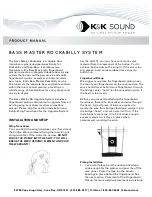
UNAOHM
20
EP2500 (Rev. 0)
7.5
RESET
To rapidly return to the factory-defined setting, press the key
↓↓
RESET (14)
twice. The instrument
returns to default conditions (see section 7.1), except for volume, brightness, contrast, which are set to
optimal average values. Memory content is never affected by the reset.
7.6
TUNING
The signal to be measured or displayed may be tuned in three modes:
1.
By programming the frequency. Press the key
FR (32)
, then follow the instructions in section. 7.4.
2.
By recalling the TV channel. Press the key
CH LO A-B (31)
(the key
AB..Z
on the numerical
keyboard
(8)
recalls the first channel which is alphabetically present), then follow the instructions in
section 7.4.
NOTE
:
•
Rotating the shaft encoder overrides any partial number you may have keyed in through the keypad
by mistake, so you can begin again to key in the correct number.
•
The instrument offers different channel format to suit the different channel formats of the country
the unit is being used, for the selection of which please see Chapter
8
, UTILITY.
•
The symbols
Î
and
Í
to the right of the OSD value indicate that the frequency tuned is,
respectively, higher/lower than the nominal channel frequency.
•
Always press
↵
to confirm your entry. After confirmation it is possible to increase/decrease the
value by means of the Shaft Encoder.
3.
By recalling one of the previously stored programs. Press the key
PR (33)
, then follow the
instructions in section 7.4.
7.6.1
SAT Tuning by Means of Transponder Frequency
In satellite band it is possible to set the frequency of two local oscillators for two different LNB’s. This,
then, makes it possible to display the transponder frequency directly for tuning instead of the 1
st
IF.
Setting procedure is as follows:
•
Press
LO+VP (29)
. The display shown in
Figure 6
will appear.
•
Select LO1 or LO2 by means of the keys
UP
and
DOWN
and then
ENTER
.
•
Set the frequency of the first oscillator (1A or 1B) by means of the numerical keys.
•
Set the frequency of the second oscillator (2A or 2B) by means of the numerical keys.
•
Press
EXIT
to exit.
The local oscillator 1 or 2, on which the cursor is positioned when
EXIT
is pressed, is the one that will
be used later for tuning.
During normal use of the instrument, if you wish to display sequencially the 1
st
IF, local oscillator A or
local oscillator B, press key
CH LO A-B (31)
.
















































